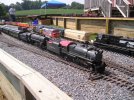Rhinochugger
Retired Oik
Well, we try not to buy at the recommended price in the UK, but in general, as the engineering quality has improved, so have the $ signs and £ signs travelled northwardsNo one buys Bachmann at the inflated list price... at least not in the US.
Greg
It,s probably not so easy here as the volume is less.

